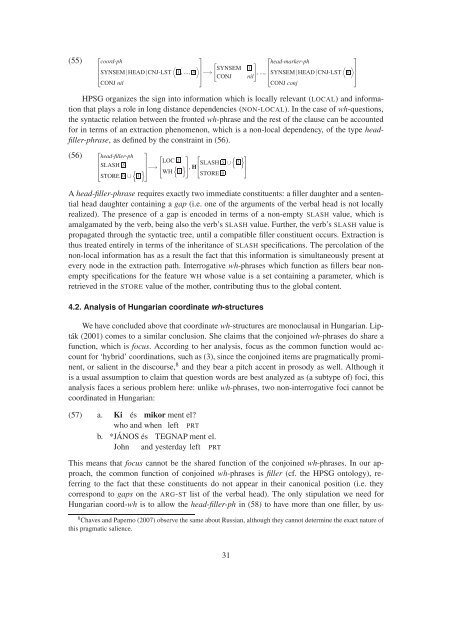Empirical Issues in Syntax and Semantics 9 (EISS 9 ... - CSSP - CNRS
Empirical Issues in Syntax and Semantics 9 (EISS 9 ... - CSSP - CNRS
Empirical Issues in Syntax and Semantics 9 (EISS 9 ... - CSSP - CNRS
Create successful ePaper yourself
Turn your PDF publications into a flip-book with our unique Google optimized e-Paper software.
(55)<br />
⎡<br />
⎤<br />
⎡<br />
⎤<br />
coord-ph<br />
[ ] head-marker-ph<br />
〈 〉<br />
⎢<br />
⎣SYNSEM|HEAD|CNJ-LST<br />
1 , ..., n ⎥<br />
⎦ −→ SYNSEM 1<br />
〈 〉<br />
, ..., ⎢<br />
CONJ nil ⎣SYNSEM|HEAD|CNJ-LST<br />
n ⎥<br />
⎦<br />
CONJ nil<br />
CONJ conj<br />
HPSG organizes the sign <strong>in</strong>to <strong>in</strong>formation which is locally relevant (LOCAL) <strong>and</strong> <strong>in</strong>formation<br />
that plays a role <strong>in</strong> long distance dependencies (NON-LOCAL). In the case of wh-questions,<br />
the syntactic relation between the fronted wh-phrase <strong>and</strong> the rest of the clause can be accounted<br />
for <strong>in</strong> terms of an extraction phenomenon, which is a non-local dependency, of the type headfiller-phrase,<br />
as def<strong>in</strong>ed by the constra<strong>in</strong>t <strong>in</strong> (56).<br />
(56)<br />
⎡ ⎤<br />
head-filler-ph ⎡<br />
⎢SLASH S ⎥<br />
⎣ { } ⎦ −→ ⎣ LOC ⎤ ⎡ { } ⎤<br />
{<br />
2<br />
} ⎦, H⎣ SLASH S ∪ 2<br />
⎦<br />
WH 1<br />
STORE 0 ∪ 1<br />
STORE 0<br />
A head-filler-phrase requires exactly two immediate constituents: a filler daughter <strong>and</strong> a sentential<br />
head daughter conta<strong>in</strong><strong>in</strong>g a gap (i.e. one of the arguments of the verbal head is not locally<br />
realized). The presence of a gap is encoded <strong>in</strong> terms of a non-empty SLASH value, which is<br />
amalgamated by the verb, be<strong>in</strong>g also the verb’s SLASH value. Further, the verb’s SLASH value is<br />
propagated through the syntactic tree, until a compatible filler constituent occurs. Extraction is<br />
thus treated entirely <strong>in</strong> terms of the <strong>in</strong>heritance of SLASH specifications. The percolation of the<br />
non-local <strong>in</strong>formation has as a result the fact that this <strong>in</strong>formation is simultaneously present at<br />
every node <strong>in</strong> the extraction path. Interrogative wh-phrases which function as fillers bear nonempty<br />
specifications for the feature WH whose value is a set conta<strong>in</strong><strong>in</strong>g a parameter, which is<br />
retrieved <strong>in</strong> the STORE value of the mother, contribut<strong>in</strong>g thus to the global content.<br />
4.2. Analysis of Hungarian coord<strong>in</strong>ate wh-structures<br />
We have concluded above that coord<strong>in</strong>ate wh-structures are monoclausal <strong>in</strong> Hungarian. Lipták<br />
(2001) comes to a similar conclusion. She claims that the conjo<strong>in</strong>ed wh-phrases do share a<br />
function, which is focus. Accord<strong>in</strong>g to her analysis, focus as the common function would account<br />
for ‘hybrid’ coord<strong>in</strong>ations, such as (3), s<strong>in</strong>ce the conjo<strong>in</strong>ed items are pragmatically prom<strong>in</strong>ent,<br />
or salient <strong>in</strong> the discourse, 8 <strong>and</strong> they bear a pitch accent <strong>in</strong> prosody as well. Although it<br />
is a usual assumption to claim that question words are best analyzed as (a subtype of) foci, this<br />
analysis faces a serious problem here: unlike wh-phrases, two non-<strong>in</strong>terrogative foci cannot be<br />
coord<strong>in</strong>ated <strong>in</strong> Hungarian:<br />
(57) a. Ki és mikor ment el?<br />
who <strong>and</strong> when left PRT<br />
b. *JÁNOS és TEGNAP ment el.<br />
John <strong>and</strong> yesterday left<br />
PRT<br />
This means that focus cannot be the shared function of the conjo<strong>in</strong>ed wh-phrases. In our approach,<br />
the common function of conjo<strong>in</strong>ed wh-phrases is filler (cf. the HPSG ontology), referr<strong>in</strong>g<br />
to the fact that these constituents do not appear <strong>in</strong> their canonical position (i.e. they<br />
correspond to gaps on the ARG-ST list of the verbal head). The only stipulation we need for<br />
Hungarian coord-wh is to allow the head-filler-ph <strong>in</strong> (58) to have more than one filler, by us-<br />
8 Chaves <strong>and</strong> Paperno (2007) observe the same about Russian, although they cannot determ<strong>in</strong>e the exact nature of<br />
this pragmatic salience.<br />
31











